-
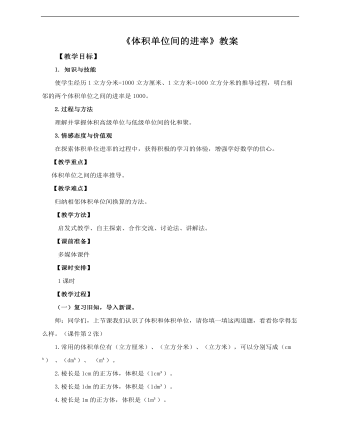
小学数学人教版五年级下册《第六课体积单位间的进率》教案说课稿
(一)复习旧知,导入新课。师:同学们,上节课我们认识了体积和体积单位,请你填一填这两道题,看看你学得怎么样。(课件第2张)1.常用的体积单位有(立方厘米)、(立方分米)、(立方米),可以分别写成(cm³) 、(dm³)、 (m³)。2.棱长是1cm的正方体,体积是(1cm³)。3.棱长是1dm的正方体,体积是(1dm³)。4.棱长是1m的正方体,体积是(1m³)。【设计意图】1dm³是多少cm³呢?这节课我们就来研究一下体积单位间的进率。(板书课题)(二)探究新知1.探究立方分米和立方厘米间的进率:(课件第3张)(1)下图是一个棱长为1dm的正方体,体积是1dm³。想一想,它的体积是多少立方厘米呢?(2)小组讨论,你是怎样想的?(3)汇报交流:(课件第4张)生1:如果把它的棱长看作是10cm,可以把它切成1000块1cm³的小正方体。10×10×10=1000.生2:它的底面积是1dm²,就是100cm²,100×10=1000,一共是1000cm³。1dm³=1000cm³【设计意图】用小组讨论的方式,让学生从讨论的过程中找到解决问题的方法,培养学生的语言表达能力、思维能力。2.你知道1m³等于多少立方分米吗?(课件第5张)生1:把棱长是1m的正方体,看作棱长是10dm的正方体,10×10×10=1000dm³。1m³=1000dm³。 生2:棱长是1m的正方体,底面积是1m²,就是100dm²,100×10=1000dm³,一共是1000dm³。生3:1m³=1000dm³ 3.整理计量单位之间的进率。(1)小组讨论:到现在为止,我们已经学习了哪些计量单位?请整理在表中。
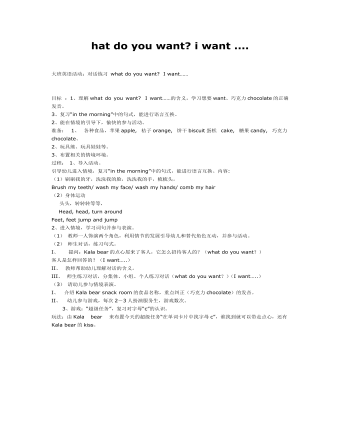
大班英语教案:hat do you want i want ....
2、玩具熊、玩具娃娃等。3、布置相关的情境环境。过程: 1、导入活动。引导幼儿进入情境,复习“in the morning”中的句式,能进行语言互换。内容:(1)刷刷我的牙,洗洗我的脸,洗洗我的手,梳梳头。Brush my teeth/ wash my face/ wash my hands/ combmy hair(2)身体运动 头头,转转转等等, Head, head, turn aroundFeet, feet jump and jump 2、进入情境,学习词句并参与表演。(1)教师一人饰演两个角色,利用情节的发展引导幼儿和替代角色互动,并参与活动。
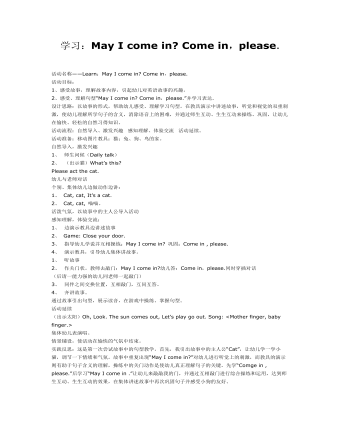
大班英语教案:May I come in Come in,please
2、感受、理解句型“May I come in? Come in,please.”并学习表达. 设计思路:以故事的形式,帮助幼儿感受、理解学习句型。在教具演示中讲述故事,听觉和视觉的双重刺激,使幼儿理解所学句子的含义,消除语音上的困难,并通过师生互动、生生互动来操练、巩固,让幼儿在愉快、轻松的自然习得知识。活动流程:自然导入、激发兴趣 感知理解、体验交流 活动延续。 活动准备:移动图片教具:猫;兔、狗、鸟的家。自然导入,激发兴趣 1、 师生问候(Daily talk) 2、 (出示猫)What’s this? Please act the cat. 幼儿与老师对话 个别、集体幼儿边做动作边讲: 1、 Cat, cat, It’s a cat.
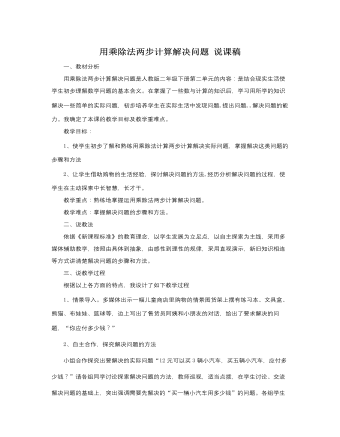
人教版新课标小学数学二年级下册用乘除法两步计算解决问题说课稿
例2是面包房买卖面包的情境。解决问题的重点是学会使用小括号列综合算式,并了解小括号的作用。通过学生熟悉的购买面包的情境,解决“还剩多少个”这个实际问题。仍然可以引导学生从不同的角度思考问题,启发列式为54-8-22或为54-(8+22)。第二种解法的综合算式,教材中特别强调“如果写成一个算式,应该使用小括号”,并明确“计算时先算小括号里面的”。因为是初次在列式时需要使用小括号,如果学生产生疑问,教师可组织学生通过回顾旧知,利用现实情境,明确使用小括号的必要性及使用方法。教学例2时可以采用与例1相似的教学方式。首先让学生观察下页图,也可以利用电教媒体创设情境,由学生提出问题,并启发学生思考如何解决。让学生充分交流研讨,畅谈自己的想法,然后着重说明解决问题的思路。列式计算时可以先分步列式,同时强调两种列式方法的内在联系,列综合算式时着重说明使用小括号的目的。
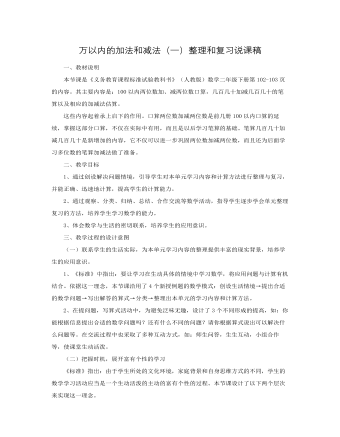
人教版新课标小学数学二年级下册万以内的加法和减法(一)整理和复习说课稿
三、估算度的把握。《标准》在计算教学方面强调的内容之一是重视估算,培养估算意识。我们认为重视估算,就是对学生数感的培养,具体体现在能估计运算的结果,并对结果的合理性作出解释。本节课的设计就是让学生在具体情境中,学会两种估算方法,结合具体情况作出合理解释。四、教会学生单元整理与复习的方法,使学生终身受益。我们知道授人以渔而非鱼的道理。在本节课中,老师设计了引导学生学会整理与复习的方法,如:带着问题看书,将算式分类、归纳、总结出本单元所学内容,计算方法,注意地方,最后进行有针对性的练习。如果我们的老师从小就有意识地对学生进行学习方法的培养,学生将终身受益。我想我们教学研讨活动就是为了实现教育的最高境界:今天的教是为了明天的不教。
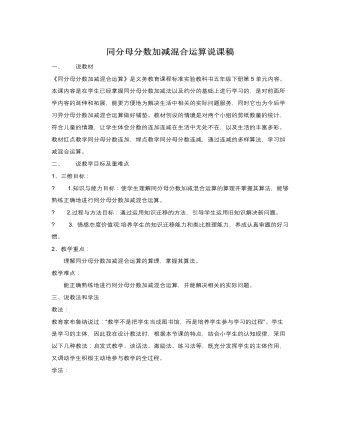
人教版新课标小学数学五年级下册同分母分数加减混合运算说课稿
4、简单小结,内化知识引导学生总结出学习的课题(教师板书),学生再明确表达出“同分母分数加减混合运算的顺序与证书加减混合运算的顺序完全相同,计算方法与同分母分数加减法的计算方法相同,即分母不变,分子相加减。注意能月份的一定要约成最简分数为止。”,(三)巩固练习、拓展应用1、基础练习2、引申练习3、解决实际问题 【精心设计练习,既有与例题程度相当的“保底”题,又有与生活密切相关的变式题,拓展思维,培养创新意识,展现数学的应用价值,让学生体会到学习数学有用,生活处处离不开数学。同时适时进行环保教育和爱国主义教育,起到了教书育人的作用。】五、说板书设计此板书力图板书的简洁美,能突出教学的重难点,提示了方法过程。
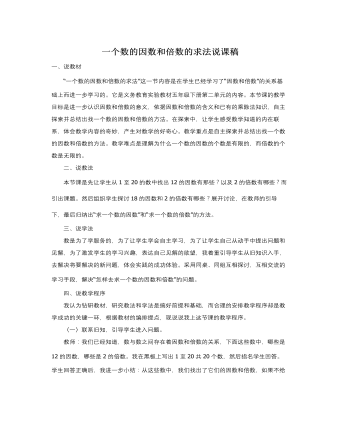
人教版新课标小学数学五年级下册一个数的因数和倍数的求法说课稿
在游戏中巩固知识,并体会区间套的数学思想,有利于培养学生的数感。做游戏时间不能过长,我只安排在4分钟内完成,让学生在学中乐和乐中学的兴趣。〈四〉全课总结今天这节课你们学了什么知识?有哪些收获?(让学生进行互说来结束本节课)五、说板书板书是体现课文内容脉落的载体。通过板书学生可以一目了然地弄请本节课你所授的内容知识的过程,让人永久深记,印象深刻。我的板书设计如下:一个数的因数和倍数的求法例1、18的因数有哪几个?18的因数有:1、2、3、6、9、18一个数的因数的个数是有限的,其中最小是1,最大的因数是它本身。方法:①哪两个自然数积等于18,则哪两个自然数就是这个数的因数。②哪个数能整除18,则哪个数就是这个数的因数。例2、2的倍数有哪些?一个数的倍数的个数是无限的,其中最小的倍数是它本身,没有最大的倍数。方法:用2与所有的自然数相乘,积就是它的倍数。
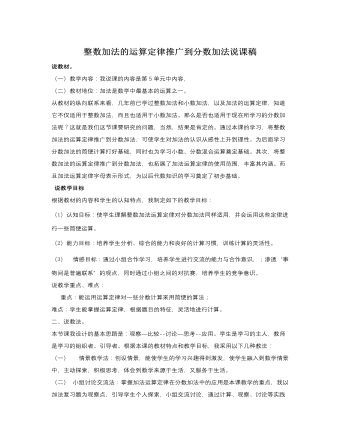
人教版新课标小学数学五年级下册整数加法的运算定律推广到分数加法说课稿
(一)教学内容:我说课的内容是第5单元中内容,(二)教材地位:加法是数学中最基本的运算之一。从教材的纵向联系来看,几年前已学过整数加法和小数加法,以及加法的运算定律,知道它不仅适用于整数加法,而且也适用于小数加法。那么是否也适用于现在所学习的分数加法呢?这就是我们这节课要研究的问题,当然,结果是肯定的。通过本课的学习,将整数加法的运算定律推广到分数加法,可使学生对加法的认识从感性上升到理性。为后面学习分数加法的简便计算打好基础,同时也为学习小数、分数混合运算奠定基础。其次,将整数加法的运算定律推广到分数加法,也拓展了加法运算定律的使用范围,丰富其内涵。而且加法运算定律字母表示形式,为以后代数知识的学习奠定了初步基础。
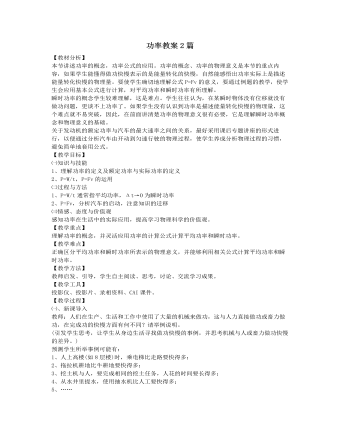
人教版新课标高中物理必修2功率教案2篇
1.用CAI课件模拟汽车的启动过程。师生共同讨论:①如果作用在物体上的力为恒力,且物体以匀速运动,则力对物体做功的功率保持不变。此情况下,任意一段时间内的平均功率与任一瞬时的瞬时功率都是相同的。②很多动力机器通常有一个额定功率,且通常使其在额定功率状态工作(如汽车),根据P=FV可知:当路面阻力较小时,牵引力也小,速度大,即汽车可以跑得快些;当路面阻力较大,或爬坡时,需要比较大的牵引力,速度必须小。这就是爬坡时汽车换低速挡的道理。③如果动力机器在实际功率小于额定功率的条件下工作,例如汽车刚刚起动后的一段时间内,速度逐渐增大过程中,牵引力仍可增大,即F和v可以同时增大,但是这一情况应以二者乘积等于额定功率为限度,即当实际功率大于额定功率以后,这种情况不可能实现。
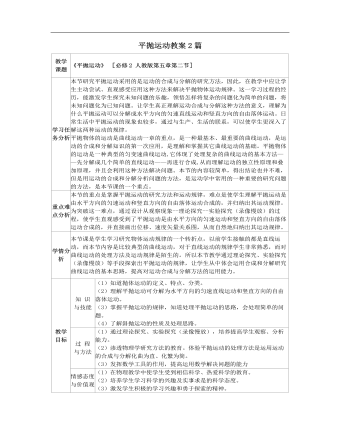
人教版新课标高中物理必修2平抛运动教案2篇
(五)平抛运动规律的应用例1:一架老式飞机在高出海面45m的高处,以80m/s的速度水平飞行,为了使飞机上投下的炸弹落在停在海面上的敌船,应该在与轰炸目标的水平距离为多远的地方投弹?不计空气阻力。分析:对于这道题我们可以从以下几个方面来考虑:(1)从水平飞行的飞机上投下的炸弹,做什么运动?为什么?(2)炸弹的这种运动可分解为哪两个什么样的分运动?3)要想使炸弹投到指定的目标处,你认为炸弹落地前在水平方向通过的距离与投弹时飞机离目标的水平距离之间有什么关系?拓展:1、式飞机在高出海面45m的高处,以80m/s的速度水平飞行,尾追一艘以15m/s逃逸的敌船,为了使飞机上投下的炸弹正好击中敌船,应该在与轰炸目标的水平距离为多远的地方投弹?不计空气阻力。2、在一次摩托车跨越壕沟的表演中,摩托车从壕沟的一侧以速度v=40m/s沿水平方向向另一侧,壕沟两侧的高度及宽度如图所示,摩托车可看做质点,不计空气阻力。(1)判断摩托车能否跨越壕沟?请计算说明(2)若能跨过,求落地速度?
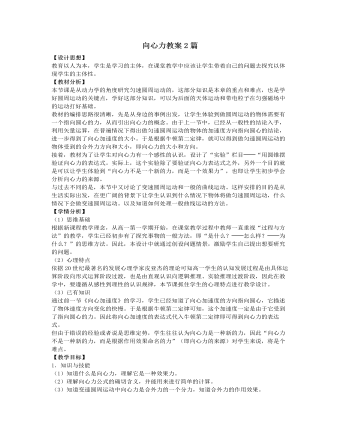
人教版新课标高中物理必修2向心力教案2篇
3.进一步体会力是产生加速度的原因,并通过牛顿第二定律来理解匀速圆周运动、变速圆周运动及一般曲线运动的各自特点。(三)、情感、态度与价值观1.在实验中,培养学生动手、探究的习惯。2.体会实验的意义,感受成功的快乐,激发学生探究问题的热情、乐于学习的品质。教学重点1.体会牛顿第二定律在向心力上的应用。2.明确向心力的意义、作用、公式及其变形,并经行计算。教学难点1.对向心力的理解及来源的寻找。2.运用向心力、向心加速度的知识解决圆周运动问题。教学过程(一)、 引入新课:复习提问:匀速圆周运动的物体的加速度——向心加速度,它的方向和大小有何特点呢?学生回答后进一步引导:那做匀速圆周运动物体的受力有什么特点呢?是什么力使物体做圆周运动而不沿直线飞出?请同学们先阅读教材
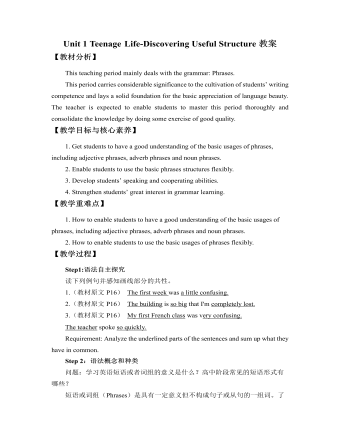
新人教版高中英语必修1Unit 1 Teenage Life-Discovering Useful Structure教案
(形容词短语most beautiful的构成形式为:副词+形容词,该短语在句中作定语修饰名词bird)④A good friend is someone who makes you really happy.好朋友就是能让你真正高兴的人。(形容词短语really happy的构成形式为:副词+形容词,该短语在句中作宾语补足语)[即学即练]画出下例句中的形容词短语并指明构成形式如:It is less cold today than it was yesterday.构成形式: 副词+形容词(1)Our country is becoming more and more beautiful.(2)The road is long enough.(3)The medicine is good for stomach.三、副词短语(Adverb Phrases)副词短语:指以一个副词为中心构成的短语,在句中的功能相当于副词,可以修饰动词、形容词或副词。常见副词短语的构成形式有:(副词)+副词如: much more beautifully①He did his work here yesterday.他昨天在这里工作。(副词短语here yesterday修饰动词did)②Bill did the work very well.比尔做的这份工作很好。副词短语very well修饰动词did③We are all entirely responsible for our action(副词短语all entirely, 修饰形容词短语responsible for)
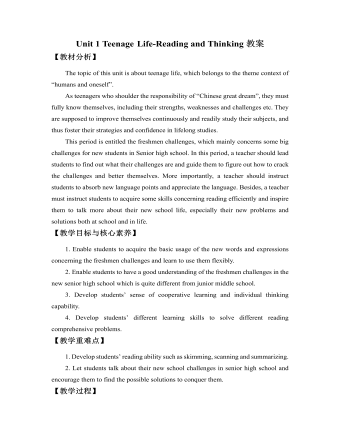
新人教版高中英语必修1Unit 1 Teenage Life-Reading and Thinking教案
【教材分析】The topic of this unit is about teenage life, which belongs to the theme context of “humans and oneself”.As teenagers who shoulder the responsibility of “Chinese great dream”, they must fully know themselves, including their strengths, weaknesses and challenges etc. They are supposed to improve themselves continuously and readily study their subjects, and thus foster their strategies and confidence in lifelong studies.This period is entitled the freshmen challenges, which mainly concerns some big challenges for new students in Senior high school. In this period, a teacher should lead students to find out what their challenges are and guide them to figure out how to crack the challenges and better themselves. More importantly, a teacher should instruct students to absorb new language points and appreciate the language. Besides, a teacher must instruct students to acquire some skills concerning reading efficiently and inspire them to talk more about their new school life, especially their new problems and solutions both at school and in life.【教学目标与核心素养】1. Enable students to acquire the basic usage of the new words and expressions concerning the freshmen challenges and learn to use them flexibly.2. Enable students to have a good understanding of the freshmen challenges in the new senior high school which is quite different from junior middle school.3. Develop students’ sense of cooperative learning and individual thinking capability. 4. Develop students’ different learning skills to solve different reading comprehensive problems.
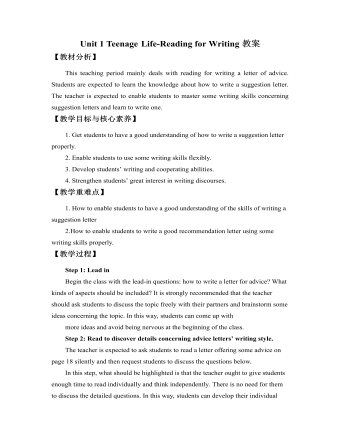
新人教版高中英语必修1Unit 1 Teenage Life-Reading for Writing教案
【教材分析】This teaching period mainly deals with reading for writing a letter of advice. Students are expected to learn the knowledge about how to write a suggestion letter. The teacher is expected to enable students to master some writing skills concerning suggestion letters and learn to write one.【教学目标与核心素养】1. Get students to have a good understanding of how to write a suggestion letter properly.2. Enable students to use some writing skills flexibly.3. Develop students’ writing and cooperating abilities.4. Strengthen students’ great interest in writing discourses.【教学重难点】1. How to enable students to have a good understanding of the skills of writing a suggestion letter2.How to enable students to write a good recommendation letter using some writing skills properly.【教学过程】Step 1: Lead in Begin the class with the lead-in questions: how to write a letter for advice? What kinds of aspects should be included? It is strongly recommended that the teacher should ask students to discuss the topic freely with their partners and brainstorm some ideas concerning the topic. In this way, students can come up with more ideas and avoid being nervous at the beginning of the class.Step 2: Read to discover details concerning advice letters’ writing style.The teacher is expected to ask students to read a letter offering some advice on page 18 silently and then request students to discuss the questions below.
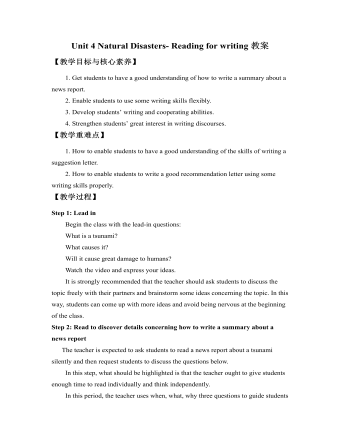
新人教版高中英语必修1Unit 4 Natural Disasters- Reading for writing教案
①标题——标题应当简洁明了。②导语——导语是消息开头的第一段或第一句话,简明扼要地揭示出消息的核心内容。③主体——主体是消息的主要部分,要用充足的事实表现主题,对导语的内容作进一步的展开和阐述。④结束语——通常是对全文内容进行概括性的总结。3. 新闻报道增分句子(1)陈述事实常用的句型:①A terrible storm hit/struck ... , killing ..②It was a cool autumn night when the earthquake happened. A large number of buildings fell down and roads were destroyed, leaving a great many people homeless.地震发生在一个凉爽的秋夜。大量的建筑物倒塌,道路被毁,许多人无家可归。③With the help of the rescue team, people who were the trapped in the flood were saved.在救援队的帮助下,困在洪水中的人们得救了。(2)陈述观点常用的句型:①Clearly/Obviously/In my opinion/It seemed that people were shocked.显然/在我看来/似乎人们震惊了。②The whole city was in ruins after the earthquake.地震后整个城市成了一片废墟。(3)揭示原因常用的句型:Because of/As a result of/Thanks to the help of the army, people who got injured were sent to the hospital immediately.
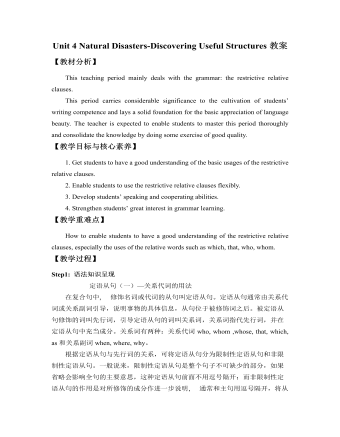
新人教版高中英语必修1Unit 4 Natural Disasters-Discovering Useful Structures教案
【教材分析】This teaching period mainly deals with the grammar: the restrictive relative clauses.This period carries considerable significance to the cultivation of students’ writing competence and lays a solid foundation for the basic appreciation of language beauty. The teacher is expected to enable students to master this period thoroughly and consolidate the knowledge by doing some exercise of good quality.【教学目标与核心素养】1. Get students to have a good understanding of the basic usages of the restrictive relative clauses.2. Enable students to use the restrictive relative clauses flexibly.3. Develop students’ speaking and cooperating abilities.4. Strengthen students’ great interest in grammar learning.【教学重难点】How to enable students to have a good understanding of the restrictive relative clauses, especially the uses of the relative words such as which, that, who, whom.【教学过程】Step1: 语法知识呈现定语从句(一)—关系代词的用法在复合句中, 修饰名词或代词的从句叫定语从句。定语从句通常由关系代词或关系副词引导,说明事物的具体信息,从句位于被修饰词之后。被定语从句修饰的词叫先行词,引导定语从句的词叫关系词,关系词指代先行词,并在定语从句中充当成分。关系词有两种:关系代词who, whom ,whose, that, which, as和关系副词when, where, why。

新人教版高中英语必修1Welcome Unit-Discovering Useful Structures教案
II Learn the technical terms-2.1. What can be used as “Subject, Object, Predicative, Direct Object, Indirect Object and objective complement” in a sentence?2. What can be used as “adverbial” in a sentence?3. What can be used as “verb” in a sentence?Answers to questions 1-3:1. Nouns, pronouns and appellations can be used as “Subject, Object, Predicative, Direct Object, Indirect Object and Objective Complement”. Besides, adjectives can be used as “Predicative and Objective Complement” in a sentence.2. Adverbs and prepositional phrases can be used as “Adverbial”.3. Verbs with actual meaning can be used as “Verb” in a sentence. Auxiliary verbs alone cannot be used as “Verb” in a sentence.III Learn to recognize the sentence structures.1. SV structure. For Example:(1) A bird flies.S V(2) A monkey jumps.S V(3) A fish swims.S V√ In SV structures, verbs are “intransitive verbs”.2. SVO structure. For Example:(1) A sheep eats grass.S V O(2) They like bananas.S V O(3) He wants candy.S V O√ In SVO structures, verbs are “transitive verbs”.3. SP structure. For Example:(1) This is great.S P (2) He looks well.S P (3) She became a teacher.S P √ In SP structures, Predicatives are formed by “link verbs” and “adjectives or nouns”.√ link verbs: be, become, grow, look, feel, taste, etc.4. SV IO DO structure. For Example:(1) He asked me a question.S V IO DO(2) Danny wrote me a letter.S V IO DO(3) Billy brought Sam a kite.S V IO DO√ In SV IO DO structures, the verbs are transitive and are followed by two objectives – pronouns or nouns as Indirect Objective, and nouns as Direct Objectives.

新人教版高中英语必修1Unit 4 Natural Disasters-Reading & Thinking教案
5. Read to get detailed information about Paragraph 5.Q1. What shows the revival of Tangshan?Q2. How can Tangshan revive itself and get up on its feet again?Q3. In times of disasters, how can we go through it?T: In times of disasters, we should unify, show the wisdom and stay positive.Step 4 Activity 4 Highlighting the theme and reflecting1. Make a summary of the text.2. Further understand the titleQ: After our learning, why do you think the earth didn’t sleep on that night?T: An earthquake happened. The people in the earthquake suffered a lot, and the people outside Tangshan were concerned about the people there a lot.3. Reflect through discussion on what can be learnt after reading.T: Disasters are powerful. Unpreparedness can be deadly. Life is weak, but if people work together to help each other, disasters can be defeated.There is no love from disaster, but we have love in the human heart.Step 5 Assignment How does the writer convey that the earthquake was deadly, and that people were helpless during the earthquake? Try to find some attractive and impressive expressions and note them down.

新人教版高中英语必修1Unit 5 Languages Around the World-Reading and Thinking教案
【教材分析】本节课是高中英语第一册的最后一个单元的阅读和思考部分,文章难度明显增加,体现在以下几个方面:文章题材是说明文,比较难理解;话题生疏,涉及到历史等知识;生词量增大,而且在语境中理解词汇的要求提高。面对这些,教师的难度和高度也要有所提升,通过探讨说明顺序,了解背景知识等帮助他们找到说明文阅读的方法。【教学目标与核心素养】1. 文化意识目标新课程中指出,文化意识是对中外文化的理解和对优秀文化的认同。文化意识的的培养有助于学生增加国家认同和家国情怀,成为有文明素养和社会责任感的人。我们这个单元很好体现了这一点,通过了解汉字书写的体系和发展,学生可以有一种文化自豪感,同时也能够帮助学生深入挖掘这篇文章,从而想到更多和中国文化相关的方面。2. 学习能力目标
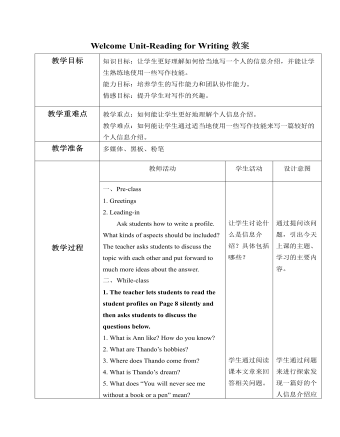
新人教版高中英语必修1Welcome Unit-Reading for Writing教案
教学目标知识目标:让学生更好理解如何恰当地写一个人的信息介绍,并能让学生熟练地使用一些写作技能。能力目标:培养学生的写作能力和团队协作能力。情感目标:提升学生对写作的兴趣。教学重难点 教学重点:如何能让学生更好地理解个人信息介绍。教学难点:如何能让学生通过适当地使用一些写作技能来写一篇较好的个人信息介绍。教学准备 多媒体、黑板、粉笔一、Pre-class1. Greetings2. Leading-inAsk students how to write a profile. What kinds of aspects should be included? The teacher asks students to discuss the topic with each other and put forward to much more ideas about the answer.二、While-class1. The teacher lets students to read the student profiles on Page 8 silently and then asks students to discuss the questions below.1. What is Ann like? How do you know?2. What are Thando’s hobbies?3. Where does Thando come from?4. What is Thando’s dream?5. What does “You will never see me without a book or a pen” mean?